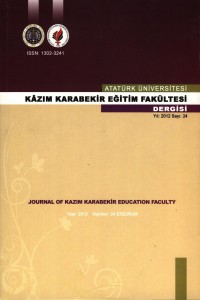BAUDELAIRE’DE SIKINTI NOKTALARI VE GÖRÜNÜMLERİ / POINTS AND ASPECTS OF SPLEEN INNER OF BAUDELAIRE / POINTS DU SPLEEN ET SES ASPECTS CHEZ BAUDELAIRE
Abstract
Bu çalışmanın amacı ‘Kötülük Çiçekleri’ adlı yapıtında Baudelaire’in şiirinin önemli bir hareket noktasını oluşturan sıkıntı sözcüğünün çeşitli biçimlerini irdelemektir. Onun şiirlerinde sıkıntı sözcüğü farklı görünümlerde ortaya çıkmaktadır. Şiirlerinde Türkçe karşılığı melal olarak çevrilmesi uygun görülen, İngilizcesi spleen olan, sıkıntı, can sıkıntısı, belli bir nedene bağlanamayan ama birçok nedeni varmış gibi görünen iç sıkıntısı, iç daralması, bunalım gibi sözcük alanı çevresinde yer alır. Sıkıntı anlam alanı ve sözcük alanı olarak İngilizce spleen, Fransızca ennui ve angoisse v.b. olmak üzere özellikle beş sözcük etrafında gelişir. Bu alandaki sözcükler ele alındığında, onlar sıkıntı anlamına gelen farklı sözcüklerle kendini göstermekte ve onun şiirine karamsar bir hava verdiği görülmektedir. İlk bakışta sıkıntı; onda iç çatışmaları ve onun ürünü olan tedirginliği, tedirginlik duygusunu yansıtmaktadır. İnsanın iç dünyasını allak bullak eden gizli kalmış duyguları açıp yaymaya çalışan bir hal gibi kendini gösterir. Onda sıkıntı, bunaltı, kin, can sıkıntısı, iç sıkıntısı, hıçkırıklar, sinsi şiddet, yaşlanma korkusu ve ölüm gibi ruh durumlarından kaynaklandığı söylenebilir.
Anahtar Sözcükler: spleen, melal, iç sıkıntısı, can sıkıntısı, bunaltı.
The aim of this study is to research various styles of word spleen which forms an important starting point of Baudelaire’s poem in his work called as ''The Flowers of Evil''. The word spleen appears in different aspects in his poems. Spleen in English approved in translation to Turkish as melal, gloom, annoyance appear in surroundings of word fields such as boredom, depression, moody which can't be attached to a certain reason but and are appeared as if they have a lot of reasons. Boredom in English as field of comprehension spleen, in French ennui and angoisse, it develops in surroundings of five words. When the words are obtained in that field it is seen that these words display themselves by different words which mean spleen and the words pretend to make of pessimism to his poem. At first glance; Spleen reflects inner conflicts of him and its results anxiety, feeling of uneasiness. The spleen displays itself like a manner which convulses inner world of man, tries to uncover and spread hidden feelings. It can be said that his spleen is based on moods such as grudge, boredom, depression, hiccups, insidious severity, afraid of being older and death, inner of him.
Key Words: spleen, ennui, boredom, annoyance, anxiety.
Le but de cette étude est d’analyser les diverses formes du mot spleen qui constitue le point de départ important de la poésie baudelairienne dans son œuvre intitulée Les Fleurs du Mal. Dans sa poésie, le mot spleen se manifeste sous les diverses aspects différents. Le champ lexical du mot spleen se progresse autour des mots l’ennui, l’angoisse, la langueur, la détresse et le cafard dans ses poèmes. Le spleen représente un état mélancolique, une dépression presque qui n’a pas de cause définie. De ce fait, le spleen qui donne une ambiance pessimiste à sa poésie devient une des composantes essentielles du mal de vivre chez lui. Ce thème constitue le plus souvent l’une des premières particularités de sa poésie. Tout d’abord le spleen reflète le sentiment d’être soucieux, les conflits intérieurs et le souci étant son produit.
Keywords
Details
| Primary Language | tr;en;fr |
|---|---|
| Journal Section | Makaleler |
| Authors | |
| Publication Date | January 4, 2013 |
| Submission Date | January 4, 2013 |
| Published in Issue | Year 2012 Issue: 24 |


